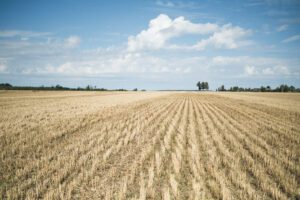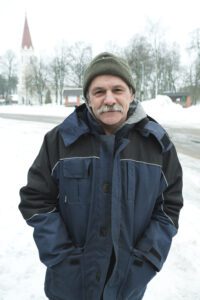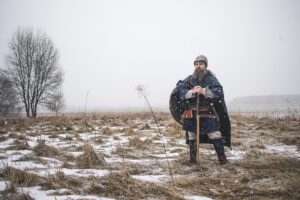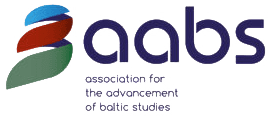AABS is pleased to recognize Ugnė Marija Andrijauskaitė for her completion of the project “Borderlands,” for which she received the Baumanis Grant for Creative Projects in Baltic Studies.
“Borderlands” was carried out as an artistic and historical (oral history) research of people living in the borderlands of three Baltic countries – Lithuania, Latvia and Estonia. It tells a visual story of the panbaltic neighbourhood and how it has changed during the soviet, post-soviet times and the global COVID-19 pandemic.

©Justinas Stonkus, 2022
The Impact of an Award: Report from Ugnė Marija Andrijauskaitė
After the completion of “Borderlands,” Ugnė Marija Andrijauskaitė submitted a reflection to AABS.
We thank her for her permission to publish her thoughts, which have been lightly edited.
Receiving the Baumanis grant allowed [me] to put these thoughts on the paper and make it into a creative research [project] that combines oral history and photography. The goal of the project named “Borderlands” was to travel in the border areas, interview people and document their everyday life, creating an exhibition that speaks to the spectator as a visual story. The project was carried out by Dr.Ugnė Marija Andrijauskaitė, a researcher who works with oral history and took care of interviews, their methodology, and preparation of collected stories for the exhibition, and by Justinas Stonkus, a photographer, who was responsible for the visual documentation.
From August 2021 to February 2022, several expeditions were made to the border areas of Lithuania/Latvia (areas of Žagarė, Joniškis, Skuodas, Šventoji in Lithuania; areas of Rucava, Jelgava, Augskalne in Latvia) and Latvia/Estonia (area of Valga/Valka, what was a particularly interesting spot as a city located in two countries). In these locations that we visited, we had scheduled meetings with local residents who agreed to share their personal stories about the life on the borderlands. Non-structured interviews were carried out and accompanied with photo shoots that allowed [us] to represent our subjects as well as the stories they shared. Moreover, spontaneous short interviews were also made on the spot, e.g. a chat with a group of curious Latvian construction workers in Rucava, Latvia, who spoke Lithuanian and proved the hypothesis that it is not uncommon to know the language of neighboring country when you are living near the border.
The Baumanis grant allowed us to carry out this project from the very beginning till the end: to do preliminary research on the topic, to plan and execute the expeditions to the border areas, and to cover the costs of transportation, accommodation, translation, as well as to print out high-quality pictures for the exhibition. In total, 16 pictures were selected for the exhibition and accompanied with short stories that were told by the people living in the border areas. The exhibition includes portraits and landscapes, covering both the personal stories and general experiences of border areas, such as traveling across the border to do some shopping, or purchasing land and other property and therefore ‘colonising’ the Latvian territory. We hope that the exhibition will inspire further research and new creative projects on the same or related topic.
Here are some notable pictures and stories from the exhibition of completed project:
I was teaching a girl who lived in Bukaičiai. She used to walk to school on foot – all she needed to do was to walk across a field to Žagarė. After the Baltic countries broke free from the USSR and country borders were reintroduced, her mother had to make a passport for her and drive her to school, nearly for 10 kilometres so they could cross the border via crossing point. It was extremely uncomfortable, as the mother’s car was checked at the border. Finally they rented a room in Žagarė, and the owner of this apartment, an elder lady, took care of the girl. Her mother would leave her there on Mondays and pick up on Fridays. – – Daiva Navickaitė | Žagarė (LT)

©Justinas Stonkus

©Justinas Stonkus
Here in Rucava everyone knows at least a little bit of Lithuanian language. Even if one can’t speak it, they can definitely understand it. I learned Lithuanian as a child when I used to watch Lithuanian cartoons on TV. I still speak it because of my job in the construction business: sometimes I get to work in Northern Lithuania, and I have to talk to my supervisors in Lithuanian. Quite often I go to Plungė since my sister lives there – she moved to Lithuania sixteen years ago after getting married to a Lithuanian man. Many Latvians go to do their shopping in Lithuania to LIDL supermarket since it’s a bit cheaper over there. Lithuanians go for their summer vacation to Latvia – to Pape, Nida and other seaside resort towns. By the way, do you know that the current Lithuanian cities Būtingė and Palanga used to be a part of Latvia a century ago?.. – – Oleg the “Curonian” | Rucava (LV)
In my opinion, the Curonian past is the greatest thing about Skuodas area. However, the locals do not appreciate it enough, but they are just simple people and don’t understand the value of our history. <…> My hobby is historical reconstruction, so I made myself a replica of a Curonian costume. Sometimes people are skeptical about this, as the Curonians no longer exist, so we are kind of trying to raise the dead. But my life is based on the idea that we have Curonian ancestors, we grew up in Samogitia, and we are working for Lithuania. – – Henrikas Ramonas | Kaunas / Skuodas (LT)

©Justinas Stonkus
The project “Borderlands” was first presented in Šiauliai (Lithuania) Museum of Photography, April 14, 2022. After the exhibition in Šiauliai, we are planning to bring it to the border towns (starting with Žagarė and Skuodas in Lithuania, TBA) and elsewhere in Latvia and Estonia.
What is the Baumanis Grant?
The Baumanis Grant is an award made to honor Velta Marija Baumanis of Mount Brydges, Ontario, who left a generous bequest to AABS at the end of her career as an architect. An award of up to $7,000 is available for any creative project (e.g., book, film, exhibit, etc.) that promotes Baltic studies. Preference is given to topics with a pan-Baltic or comparative aspect. Applicants must be members of the AABS at the time of application.
Applications for the past cycle were evaluated by the AABS 2021-2022 Grants and Awards Committee consisting of AABS VP for Professional Development Dr. Ineta Dabašinskienė, AABS President Dr. Daunis Auers, AABS Director-at-Large Dr. Andres Kasekamp, and AABS Treasurer Ugis Sprūdžs, CFA.
Other Grants and Fellowships News
Vanished Lands: Book Publication Subvention Report by Laima Vincė Sruoginis
The Association for the Advancement of Baltic Studies (AABS) is pleased to recognized the successful conclusion of a Book Publication Subvention Grant awarded to Peter Lang Publishers for publishing the book Vanished Lands: Memory and Postmemory in North American...
Elīna Vikmane Birnitis Fellowship Report on Advancing Cybermuseology
AABS is pleased to recognize Elīna Vikmane for the completion of her dissertation "Advancing Cybermuseology: Diffusion of digital innovation in Latvia’s museum sector," for which she received the 2022–2023 Aina Birnitis Dissertation-Completion Fellowship in the...
AABS 2024 Grant and Fellowship Applications Open
Call for Applications AABS 2024-2025 Grants and Fellowships Research Grants for Emerging Scholars The Aina Birnitis Dissertation-Completion Fellowship in the Humanities for Latvia Mudīte I. Zīlīte Saltups Fellowships Jānis Grundmanis Fellowships for...



